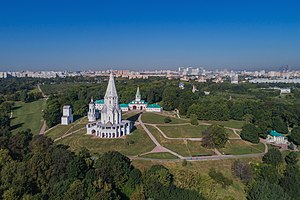Kolomenskoye
Kolomenskoje ( Russian Коло́менское ) is an old tsar's residence southeast of downtown Moscow , which in earlier centuries was on the then important route to Kolomna . The picturesque surroundings on the Moskva River were added to the urban area in 1960.
Ascension Church
The village of Kolomenskoye was first mentioned in the will of Moscow Grand Duke Ivan Kalita in 1336. Over time, the village developed into a popular country residence for the Moscow rulers. The oldest surviving structure is the unique Church of the Assumption of Christ (1532) made of white stone, which was to commemorate the long-awaited birth of the heir to the throne, the later Tsar Ivan the Terrible . As the first stone church of tent-like shape, the “White Column” marked a daring break with the Byzantine architectural tradition that had prevailed in Russia up to that point .
The church is based on a low, cross-shaped ground floor (Podklet; Russian подклет), followed by an elongated Tschetwerik (Russian четверик = octagonal body) and then an octagonal tent roof , crowned by a small dome. The narrow pilasters on the sides of the Tschetwerik, the arrow-shaped window frames of the three rows of Kokoschniki , the balanced rhythm of the staircase arcades and the open galleries underline the dynamic tendency of this masterpiece of Russian architecture. It is believed that the structure's vertical structure and its world's first stone tent-shaped roof were taken from the wooden churches of northern Russia. In 1994, taking into account its unique importance, UNESCO decided to add the church to the World Heritage List .
The great palace and other structures
On the other side of the Kolomenskoye Gorge is the Church of John the Baptist , which is dated around 1547. The exact time of its completion is not known. There are opinions that their builders were Italian builders, others attribute the authorship to Postnik Jakowlew, the builder of St. Basil's Cathedral on Red Square . Whatever the truth, the church is commonly understood as an intermediate step between the Resurrection Church and St. Basil's Cathedral with the onion-shaped domes .

Tsar Alexei I had all previous wooden structures in Kolomenskoye demolished and replaced them with a new large wooden palace, famous for its imaginative, fairytale-like roofs. Foreigners described the huge labyrinth of many corridors and 250 rooms, all of which were built without using a single nail, hook or saw, as the "eighth wonder of the world". The future Empress Elisabeth Petrovna was born in this palace in 1709. After the court moved to Saint Petersburg , the palace deteriorated and Catherine the Great also refused to take up residence in Moscow. The palace was demolished in 1768 on their behalf. By 2010, the Moscow government had the palace reconstructed according to old plans.
The remains of the palace complex include the five-vaulted Kazanskaya Church (1662) as well as the stone and wooden entrance gates. During the Soviet era, old wooden buildings from northern Russia and Siberia were transported to Kolomenskoye and an open-air museum was set up. Many of the buildings it contains date back to the 17th century.
The Moscow River in Kolomenskoye
Web links
- Official site on mgomz.com (English)
- A Kolomenskoye special on Russia News
- Kolomenskoye Open Air Museum (Moscow)
Coordinates: 55 ° 40 ′ 10.2 " N , 37 ° 40 ′ 8.4" E








